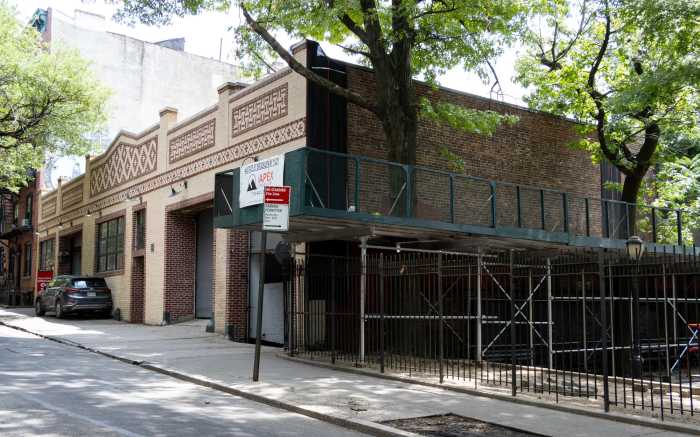Bruce Ratner has reportedly sent his world-renowned architect Frank Gehry
back to the drawing board to revise the developer’s 24-acre arena-and-skyscraper
project at the Atlantic Yards.
And Gehry has just two weeks to come up with a new scheme, according to
a report in Crain’s New York Business this week.
Ratner’s sudden rejection of Gehry’s initial design — whose
mammoth scale and glitzy aesthetic stunned even supporters of the project
when it was unveiled in July — was viewed with suspicion by longtime
opponents.
“Ha!” said Prospect Heights activist Patti Hagan.
“Anytime Ratner sends drawing back to Gehry back for a redesign it
comes back bigger and uglier.
“That last drawing looked like an explosion was going on. Very garish
— or should I say ‘Gehryish.’”
Gehry’s preliminary design — unveiled amid much ballyhoo in
Dec. 2003 — featured three soaring office towers and 4,500 new apartments
flanking an arena.
But only the glass-walled arena had been fully designed at that time.
The rest of the project — presumably to feature Gehry’s iconic
curved metal style — was rendered in bare blocks.
But last July, Gehry unveiled a substantially different — and substantially
bulkier — look for Atlantic Yards. The project now included 15 Vegas-style
towers and three more acres of footprint.
The total project would comprise 7,300 units of housing and 1.9 million
square feet of office space.
It remains unclear what Ratner has asked Gehry to change — but architects
said that redesigns are quite common during the development process.
“Renderings change with the wind,” said Manhattan architect
Sitil Patel. “They’re like politicians’ principles —
they change depending on what developers think they can get done.”
David Smiley, an architecture professor at Columbia University, added:
“Part of what happens in this stage of the process is just the show
of adjustment and changes. Changes made now could be very substantial
things or it could be window dressing.”
Negative community reaction to Gehry’s July design made even Ratner
supporters question the direction of the project.
Borough President Marty Markowitz — a strong supporter of Ratner’s
initial plans — began calling for a downsizing of the project during
his run for reelection this fall.
And two state Assemblymembers who had supported the plan have also recently
expressed their concerns.
Smiley, the Columbia professor, thought the negative reaction might have
pressured Ratner into sending Gehry back to the drafting table.
“The design [in July] was quite a bit different than it had been
in any model before,” he said.
“Whether people think Brooklyn is the place for it or not, the design
had gotten big and more dynamic.”
Markowitz cites building height as an element of the project that should
change but has not come out publicly with any other suggestions for revision.
“Since I am not an urban planner, I want to explore all options that
reduce the scale of the project while still maximizing the affordable
housing, jobs, open space and maintaining a world-class arena,” he
said in a statement.
Ratner declined to comment on how — or even whether — the new
design would change. But observers say the revisions point to an inevitable
truth about the controversial project: It is a work in progress.
Though still supported by the majority of elected officials, the project
has a long road to fruition.
Before construction can begin, two state agencies — the Empire State
Development Corporation and the Public Authorities Control Board —
must approve funding for the plan.
That process begins in January.
“We have time to make the buildings fit to the Brooklyn skyline,”
said former borough historian John Manbeck. “I’d like the buildings
a little more traditional and shorter — that’s an ideal. But
of course, Ratner is not a philanthropist. Bill Gates maybe — not
Ratner.”
It’s not the first time Gehry has had to revise initial designs.
In fact, he was forced to sandblast the metal roof of his famed Walt Disney
Concert Hall in Los Angeles in 2003 when drivers complained they were
being blinded by the glare.
“You would have thought he would have thought about the glare being
that he lived in LA for decades,” said Aric Chen, an architecture
gossip writer.
“Gehry is used to getting carte blanche, but at the same he is known
to be flexible.”
In Brooklyn, the concern has not been glare, but traffic, congestion and
community input.
Mayor Michael Bloomberg has called the mega-project a “capstone”
of Brooklyn development. The mayor pledged that no city money would be
needed to fund the project directly.
The project would be built in stages, with the arena going up first, with
a scheduled opening in 2008. Tax revenue generated by the arena through
the sale of everything from tickets to hot dogs to parking to even the
players’ multi-million-dollar salaries, would finance the rest of
the project.
Hearings in January will be held by the Empire State Development Corporation
and will be followed by an up-or-down vote by the Public Authorities Control
Board –– the same little-known state panel that killed the West
Side Stadium proposal earlier this year.
Gov. Pataki and Senate Majority Leader Joe Bruno are known to support
the project, while Assembly Speaker Sheldon Silver is playing his typical,
Sphinx-like role.
‘We are listening to all kinds of opinions,” said Eileen Larabee,
his spokeswoman.
Although the approval process is similar to the failed West Side stadium
bid, there is at least one main difference.
Atlantic Yards requires far less public funding — a direct allocation
of an estimated $200 million for the $3.5-billion project as opposed to
the $1 billion in public cash that would have made the $2.2-billion Jets
stadium possible.
If Atlantic Yards gets past the Albany hurdles early next year, it will
still take at least eight more years for it to be completely built, officials
said.
























